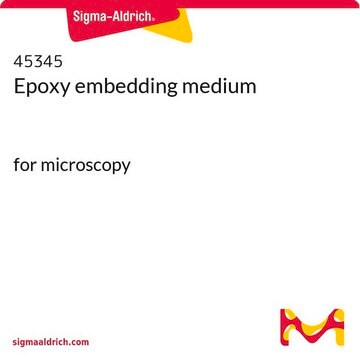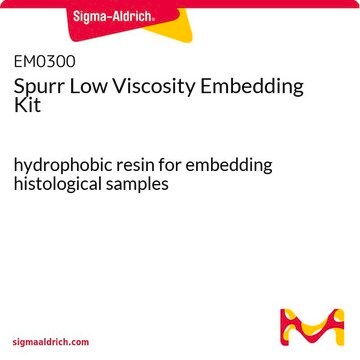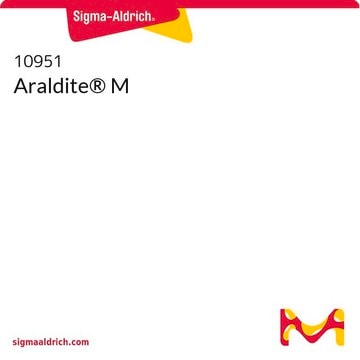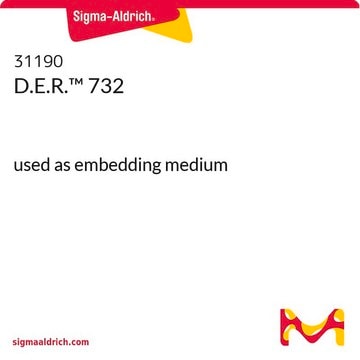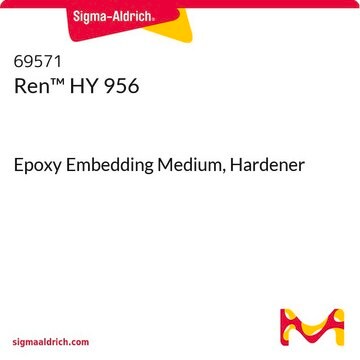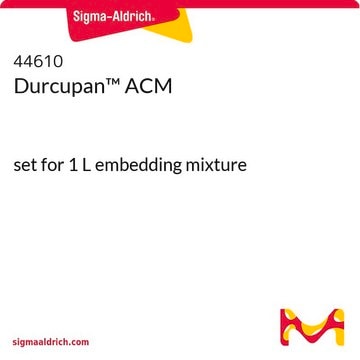45359
Epoxy Embedding Medium kit
embedding resin for electron microscopy
Synonym(s):
Epon™ substitute embedding medium kit
Sign Into View Organizational & Contract Pricing
All Photos(1)
About This Item
UNSPSC Code:
12171500
NACRES:
NA.47
Recommended Products
pH
5-7
density
1.9 g/cm3
application(s)
hematology
histology
storage temp.
2-8°C
General description
The Epoxy Embedding Medium Kit is a very widely used embedding medium for electron microscopy. The embedding formulation originally published by Luft (1961) is excellent for both plant and animal tissues. Due to the low viscosity of the resin, it penetrates the tissue specimen faster than Araldite and other polymers. It hardens easily and uniformly at low temperatures with the addition of dodecenylsuccinic anhydride (DDSA), methyl nadic anhydride (MNA), and the accelerator 2,4,6-tris(dimethylaminomethyl)phenol (DMP-30). Slight shrinkage may occur during curing. This kit is useful for embedding a variety of tissues as a wide range of hardness can be obtained with this resin to suit a specific tissue type by using two different anhydride curing agents (DDSA and MNA).
Application
Epoxy Embedding Medium Kit has been used in the following applications:
- to study the role of NDRG2, an essential colonic epithelial barrier regulator, in gut homeostasis maintenance and colitis-associated tumor development
- to study the interaction of polymer scaffold nanofibers with growing cells
- to study the morphological characterization of postembryonic development of blood–spleen barrier in ducks
- to understand the role of NOD1/NOD2 receptors in Fusobacterium nucleatum-mediated neutrophil extracellular traps
Features and Benefits
- Excellent medium for embedding a wide variety of tissues, including both plant and animal.
- Facilitates rapid embedding (less than 3 hours).
- Low viscosity facilitates rapid tissue penetration.
- Desirable hardness is easy to obtain to suit a specific tissue type.
Components
45345 Epoxy Embedding Medium 2x250 ml
45347 Hardener MNA 250 ml
45346 Hardener DDSA 250 ml
45348 Accelerator DMP 30 250 ml
45347 Hardener MNA 250 ml
45346 Hardener DDSA 250 ml
45348 Accelerator DMP 30 250 ml
Legal Information
Epon is a trademark of Hexion, Inc.
related product
Product No.
Description
Pricing
Signal Word
Danger
Hazard Statements
Precautionary Statements
Hazard Classifications
Acute Tox. 4 Oral - Aquatic Chronic 4 - Eye Dam. 1 - Resp. Sens. 1 - Skin Corr. 1B - Skin Sens. 1 - STOT SE 3
Target Organs
Respiratory system
Storage Class Code
8A - Combustible corrosive hazardous materials
Flash Point(F)
275.0 °F
Flash Point(C)
135 °C
Certificates of Analysis (COA)
Search for Certificates of Analysis (COA) by entering the products Lot/Batch Number. Lot and Batch Numbers can be found on a product’s label following the words ‘Lot’ or ‘Batch’.
Already Own This Product?
Find documentation for the products that you have recently purchased in the Document Library.
Customers Also Viewed
A Sawaguchi et al.
Journal of microscopy, 234(2), 113-117 (2009-04-29)
The goal of specimen preparation for transmission electron microscopy is to obtain high-quality ultra-thin sections with which we can correlate cellular structure to physiological function. In this study, we newly developed a capsule-supporting ring that can be useful for resin
Kunio Nagashima et al.
Methods in molecular biology (Clifton, N.J.), 697, 83-91 (2010-12-01)
This chapter outlines the procedures for ex vivo TEM preparation of nanoparticle-containing tissue or cell culture samples using an epoxy resin embedding method. The purpose of this procedure is to preserve the structure of tissue in a hardened epoxy block
Arnold Lavaud et al.
Translational vision science & technology, 9(5), 13-13 (2020-08-22)
To evaluate visual streak (VS) identification on spectral-domain optical coherence tomography (SD-OCT) scans in awake rabbits. To report thickness measurements in the VS and adjacent retina on OCT B-scans and histologic sections and to assess inter-method bias, precision and repeatability
Role of NOD1/NOD2 receptors in Fusobacterium nucleatum mediated NETosis
Alyami, et al.
Microbial Pathogenesis (2019)
High resolution 3D microscopy study of cardiomyocytes on polymer scaffold nanofibers reveals formation of unusual sheathed structure
Balashov, et al.
Acta Biomaterialia (2018)
Our team of scientists has experience in all areas of research including Life Science, Material Science, Chemical Synthesis, Chromatography, Analytical and many others.
Contact Technical Service